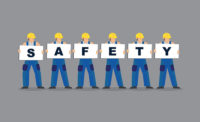The term “Safety culture” has become like the term “engagement” in popular management writings. There is no common agreement on the term.
We are left with (mis)interpretations of terms like “safety culture,” which lead to haphazard attempts at changing organizations toward improvement. Thus, the term has been begun to diffuse into meaninglessness like so many good-ideas-turned-fad before. This is too bad because the real concept of safety culture is profound and can lead to significant improvements.
I’m a psychologist so I’m used to being around terms constructed to describe things that are not concrete. The term “culture” has been over-studied in industrial/organizational psychology and all we are left with is an argument over the difference between “culture” and “climate.” Even as a psychologist, I have had a big problem getting my arms around what a “culture” is. For me the best definition was putting a swab of spit in a petri dish and see what grows.
However, as a behavioral psychologist, parsimony is the goal. When we shave away the fluff from terms like “safety culture” with a tool like Occam’s Razor we end up with an extensively more useful concept.
Definition of Occam’s Razor
“Entities should not be multiplied unnecessarily. The simplest of competing theories be preferred to the more complex. Explanations of unknown phenomena be sought first in terms of known quantities.” -- Merriam-Webster Dictionary
It’s all in the conversation
Let’s try this on for size: Safety culture is how people talk to each other and how that talking impacts safety behaviors.
- Consider the employee telling another about a short cut to a task that involves risk -- the culture influences risk.
- Consider a supervisor who emphasizes speed in getting a piece of equipment back on line -- the culture influences risk.
- Consider a leader who tells subordinates to push the equipment upgrades off for yet another year to save costs -- the culture influences risk.
- Alternatively, when an employee takes a moment to alert another employee when they are taking a risk -- the culture influences safety.
- When a supervisor asks his work team about the potential hazards in a job and discusses the safe behaviors that mitigate the hazards -- the culture influences safety.
- When a leader asks his subordinates about the safety implications of budget decisions -- the culture influences safety.
Management systems = verbal behaviors
Note that this happens through all levels of the organization. It is not necessarily top-down or bottom-up. It can be motivated with programs like People-Based Safety where the whole point is getting employees to talk to each other about risk. There are solid management programs like LEADS that focus on leadership verbal behaviors.
Note also that safety management systems are just formalized methods of communication:
- Minor Injury/Close Call reporting = talking about incidents that happened instead of hiding them;
- Safety Procedures = written talking about safe behaviors on a job;
- Training = talking, alot;
- Discipline = telling employees the consequences of their actions; etc...
The question here is: how effectively are these systems talking to your employees and managers?
Talk it up
The verbal behaviors that can create a positive safety culture are reinforced just like any other behavior. You reinforce when people talk about safety, report minor incidents, and point out risk. Do this and these behaviors increase. When these verbal behaviors increase, they happen more in the work site. When more safety talking occurs then more people will try it themselves, modeling those who do. They, in turn, will get reinforced by this emerging safety culture and the safety talking builds and builds.
Most importantly, data shows that talking to someone about safety can help change their behavior. But most, most importantly, talking to someone about safety makes it 2X more likely that you’ll change your own behavior.
Why mess with a messy concept of safety culture. Instead, cut the fat and recognize safety culture for what it is -- people influencing each other by talking. With this recognition comes a definition we can do something with, something we can operationalize into useful tactics to reduce injuries.
So “Talk the Talk”!
"Plurality must never be posited without necessity."— William of Ockham (1285 -1349)





